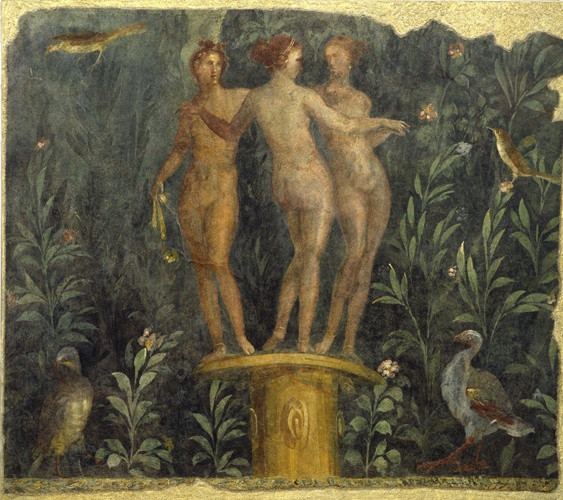
Fresco
H (greatest): 114.8 cm; W (greatest): 134.3 cm
Allegedly from Stabiae
Fourth Style
c. A.D. 60
Painted by the fresco technique [1]. It would appear that the intonaco was greyish. The first layer of paint was green, the general background colour; it would have been burnished to bring out the moisture, in order to enable the varying shades of colour: green and grey, reddish brown, a plum-coloured maroon, yellow, touches of white, to adhere. The paint is thickest on the figures of the Three Graces, the central composition of the painting.
The lower border a garland of leaves from either side that meet at the centre and serve to cover the join between two zones [2]. The colour of the wall around the painting is unknown.
Condition: good, but the top and side borders missing. Surface with fissures visible mostly in the lower half, one long fissure runs across the whole panel passing through the midriff of the Three Graces.
Missing: the edges of the painted surface at the upper left hand corner with considerable loss of painted surface on the top right hand side and below the corner; also small patches here and there filled in and touched up in tratteggio [3].
The surface is somewhat worn on the upper part of the panel and in a few other places, there is some serious loss of paint on the torso of the central figure and the Grace on her right, these surfaces have been visibly touched up in tratteggio. A certain amount of wear shows up here and there, e.g. on the right side of the left figure.
The painting before restoration [4] was in one piece but the surface of the panel in several places on different levels, with a few important fissures.
The Three Graces grouped harmoniously, in keeping with their symbolism, stand atop a gilded candelabrum [5], the background a garden with flowering plants and shrubs. All three wear anklets, the outside two have ear-rings, their hair appears to be held by a ribbon that circles their heads and two of them have their hair tied up at the back. The figure on the left with hair tied on top of her head - a hair-style of Aphrodite - holds in her lowered right hand a yellow ribbon.
The scenery of green plants is poetical and naive, enlivened by flowers and birds. A red nightingale on the upper left hand corner and another slightly down on the right side perched on plants. On the foreground and on either side what appears to be a rock partridge (Alectoris graeca), the left one raising his left leg as he looks back over his right shoulder, while his companion on the right proudly struts towards the centre.
The origin of the Three Graces is uncertain, but there is mention in Homer; Hesiod is the first who says that they are three in number - Euphrosyne, Thalia and Aglaia - and the daughters of Zeus and Eurynome. In early times they were adored as nature divinities associated with life and fertility. Pausanias tells us that they belonged to Aphrodite, goddess of Spring and beauty. Their cult was practised throughout Greece and the oldest and most famous of their sanctuaries was at Orchomenos in Boeotia where they were represented by stones.
Whether their appearance harks back to an original in painting or sculpture is uncertain though A. Furtwängler thought that since meant to be seen from one side, a painting was probably the first representation of them in their present poses.
Clothed in early antiquity they were shown naked from Hellenistic times onwards.
The closest parallels in painting are the two examples in Naples [6] that come from Pompeii. Notable is that on both of these the outside Graces, their hair-styles varying from that of ours, look outwards whereas on our panel they look in towards the central figure, indicating a different prototype for our painting.
Physically and intellectually they represented charm, grace and beauty, but philosophically they have a moral significance. It would seem that since Aristotle there was a play on the double meaning of the word "charis" which signifies not only "grace" but the "service that one renders or receives". The Stoics considered that the attitude of the Three Graces symbolized the ties between the one who renders service and the one who received it. Servius in his commentary on the Aeneid explains their interrelation and the fact that one is shown from the back; it is because when we do a good deed it is returned to us twofold [7].
On view: Musée d'Art et d'Histoire, Geneva: 1976-1978
1 See Landscape, cat. no. 226 footnote 1.
2 Verbal communication Mrs. Alix Barbet.
3 See Landscape, cat. no. 226 footnote 2.
4 Ateliers et Laboratoire Crephart, Genève, 1972.
5 Verbal communication Mrs. Alix Barbet.
6 Archaeological Museum nos. 9231 (H: 53 cm; W: 47 cm), Reg. VI, ins. Occid., Third Style?, 9236 (H: 56.5 cm; W: 53.5 cm), Reg. IX, 2, 16, from the tablinum K of the villa of T. Dentatus Panthera, Third Style?: Barbet, A.: in: Guillaud, J., Guillaud, M.: La Pittura a Fresco al Tempo di Pompei (Paris/New York, 1990), pp. 8-9 col. ill.
7 Lavagne, H.: Les Trois Grâces et la visite de Dionysos chez Ikarios sur une mosaïque de Narbonnaise, in: Fifth International Colloquium on Ancient Mosaics, Bath, part I; Suppl. JRA (Ann Arbor, 1994), pp. 238-248, part. 247. For this reference we are much indebted to Mrs. Alix Barbet.